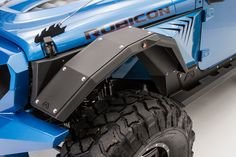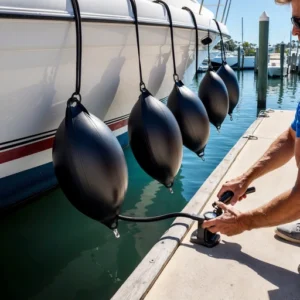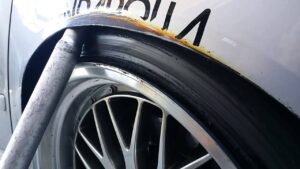If you’re thinking about customizing your vehicle in West Virginia, maybe adding some bigger tires or lifting your truck—you’ve got to know the rules around tire and fender clearance. It’s not just about getting that rugged look; it’s about staying on the right side of the law and keeping things safe on the road. A common question that pops up is, “How far can tires stick out past fenders in WV?” It might sound like a simple query, but getting it wrong could lead to fines, inspection failures, or even frequent stops by the police.
So, why does West Virginia have these laws? It’s all about safety. When tires stick out too far past the fenders in WV, they can throw up rocks, mud, and other debris, creating hazards for other drivers. This isn’t just a nuisance—it can lead to accidents. Plus, the stability of your vehicle could be compromised, especially when making sharp turns or driving at high speeds. That’s why knowing the “West Virginia fender laws” and “WV tire regulations” is crucial for anyone looking to make vehicle modifications.
In this blog, we’ll break down what you need to know about WV tire and fender laws so you can drive confidently, knowing you’re fully compliant and safe.
Understanding West Virginia Tire and Fender Laws
Alright, let’s dive into the specifics. West Virginia has clear rules regarding how far your tires can extend beyond the fenders. These are part of the “West Virginia vehicle modification laws” designed to keep everyone safe on the roads. If your tires stick out too far, you could face penalties, fail an inspection, or get pulled over by law enforcement.
1. The Legal Distance for Tire Protrusion in West Virginia
So, how much can tires stick out past fenders in WV? According to the “WV tire protrusion laws,” the law states that the tread of the tire must be covered by the vehicle’s fenders, mud flaps, or fender flares. The general rule of thumb is that tires should not extend more than a couple of inches beyond the fenders. If you’re driving a standard passenger vehicle or a light truck, your tire tread should not protrude beyond the fender’s edge without proper coverage. This is to ensure that rocks, mud, and debris don’t get kicked up from your tires and cause issues for other drivers.
It’s also important to note that these rules apply to all vehicles on public roads in West Virginia. So, whether you’re driving a modified truck, a jeep, or a sports car, the same “WV fender flare laws” apply. Ensuring your vehicle meets these standards helps you avoid fines, penalties, and the hassle of failing a vehicle inspection.
2. How is Tire Protrusion Measured?
You might be wondering, “How do they measure tire protrusion?” Great question! In West Virginia, tire protrusion is typically measured from the outermost edge of the fender to the outermost part of the tire tread. This measurement helps determine whether your tires comply with the “vehicle fender coverage laws in WV.” If you’ve added wheel spacers or have a negative wheel offset that pushes your tires out too far, you might be in violation of the law.
During a state inspection, officials will look closely at the “tire and fender alignment” to ensure everything is within legal limits. If your tires extend beyond what’s allowed, you’ll need to either adjust your wheel setup or add proper fender flares to cover the extra width. Keeping within the guidelines is key to passing inspections and avoiding fines.
3. Why Are These Laws Important?
The main reason behind these “West Virginia tire and wheel modification guidelines” is to keep the roads safe for everyone. Vehicles with tires that stick out too far past the fenders in WV can pose a risk not only to the driver but also to other road users. Imagine driving behind a truck with oversized tires that fling rocks at your windshield. That’s not just annoying—it’s dangerous.
That’s why the state enforces these “tire protrusion rules for lifted trucks in West Virginia.” Staying within legal limits ensures safer driving conditions, reduces road hazards, and keeps you from getting pulled over by the police. Plus, it helps maintain the stability of your vehicle, especially if you’ve made other modifications like installing a lift kit or adjusting the suspension.
4. Consequences of Not Following WV Tire Protrusion Laws
If you don’t follow the “West Virginia tire safety regulations,” you could face several consequences. First, you might fail your annual vehicle inspection, which is required to keep your car legally on the road. Failing the inspection means you’ll have to fix the issue and get your vehicle re-inspected, costing you time and money. Additionally, law enforcement can issue fines if your tires are found to be in violation while driving. Repeated violations can lead to more severe penalties, including mandatory repairs or even impoundment of your vehicle until it meets the legal standards.
To avoid these headaches, it’s essential to be aware of the “WV vehicle modification tire laws” and ensure your modifications, especially concerning tires and fenders, comply with them.
Key Factors That Influence Tire Protrusion Legality in WV
If you’re planning to modify your vehicle in West Virginia, understanding the factors that can affect whether your tire protrusion is legal is crucial. It’s not just a matter of slapping on some bigger tires and hitting the road. There are specific things to consider, from the type of vehicle you drive to the kind of modifications you’ve made. Let’s break down these key factors to help you stay on the right side of the law.
1. Type of Vehicle Makes a Difference
First things first, the type of vehicle you have can significantly impact how far your tires can stick out past the fenders in WV legally. Are you driving a lifted truck, an SUV, a standard sedan, or a custom jeep? Each vehicle type may have slightly different requirements under “West Virginia vehicle modification laws.”
For example, lifted trucks often come with wider tires and custom wheels that might protrude beyond the fenders. In West Virginia, these “tire protrusion rules for lifted trucks” are quite specific. If you have a passenger car or a light truck, you typically have less room to play around with. The “legal tire protrusion in WV” must be minimal to avoid throwing up rocks, mud, or other debris onto the road.
Trucks and off-road vehicles might have a bit more leeway when it comes to modifications, but they still need to comply with “WV road laws for lifted trucks.” Make sure to know the limits based on your vehicle type before making any changes.
2. Wheel Size and Offset
The size of your wheels and the “wheel offset” are also critical factors. Wheel offset refers to how far your wheel sits inside or outside the wheel well. A positive offset means your wheels are closer to the vehicle’s body, while a negative offset pushes them further out. If you have a significant negative offset, your wheels could extend too far beyond the fenders.
This is where “WV fender laws” come into play. If your wheels are pushed out too far due to a negative offset, it could cause your vehicle to fail an inspection. The “WV tire and wheel modification guidelines” require that the tire tread stays within a certain distance from the fenders to prevent any road hazards.
3. Modifications Like Wheel Spacers and Fender Flares
Many car enthusiasts use “wheel spacers” to create a wider stance for their vehicles. While this can look cool and add a more aggressive look, it can also push your tires out past the legal limit. If your tire tread extends too far, you could be violating “West Virginia state police tire laws.”
To stay within legal limits, consider adding “fender flares.” These flares are designed to extend the fenders’ coverage, ensuring that any extra tire width is adequately covered. They are especially useful if you’re running wider tires or have installed a lift kit. Fender flares help you stay compliant with “WV fender flare laws” without having to change your wheel setup completely.
4. Lift Kits and Suspension Changes
If you’ve installed a lift kit or made significant changes to your suspension, this can also affect how far your tires stick out. Lifted vehicles often have larger tires, which can protrude past the fenders. If you’re thinking about lifting your truck, make sure to check the “West Virginia vehicle modification guidelines.”
Lift kits can dramatically change your vehicle’s dynamics, including tire and fender alignment. To ensure you stay within “WV vehicle tire modification laws,” it’s always a good idea to consult with a professional mechanic who knows how to keep your modifications both safe and legal.
Steps to Ensure Compliance During Vehicle Inspection in West Virginia
So, you’ve decided to go ahead with some modifications—great! Now comes the part where you need to make sure everything is legal and ready for inspection. In West Virginia, the inspection process can be quite detailed, especially for modified vehicles. Here’s what you need to know to make sure your ride is inspection-ready.
1. Understanding the West Virginia Car Inspection Process
In West Virginia, every vehicle must pass an annual safety inspection to ensure it meets all road safety and environmental standards. If you’ve got modified tires that stick out past the fenders, this will be closely examined during the inspection. Inspectors will check for “WV regulations for tire and fender coverage” to see if your vehicle’s tires comply with state laws.
If you have wide tires, lifted trucks, or a custom setup, be prepared for a detailed inspection. Officials will look closely at “tire and fender alignment,” wheel offset, and any modifications like “wheel spacers” or “fender flares.” If your tires extend too far beyond the fenders and aren’t covered properly, you could fail the inspection.
2. Common Reasons for Failing Inspection Due to Tire Protrusion
There are several reasons your vehicle might fail inspection in West Virginia due to tire protrusion issues:
- Tires Sticking Out Too Far: This is the most common reason. If your tire tread extends too far beyond the fenders, you’ll need to address the issue before you can pass.
- Missing or Improper Fender Flares: If your tires are wide but you don’t have adequate fender flares, that’s another common failure point. Make sure any flares are properly installed and cover the necessary width.
- Incorrect Use of Wheel Spacers: If you’ve added wheel spacers to push your tires out and haven’t adjusted the fender coverage accordingly, this could lead to an inspection failure.
Understanding these potential pitfalls helps you stay ahead and avoid any surprises when it’s time for your vehicle inspection.
3. Tips for Passing Inspection in West Virginia
- Measure Tire Protrusion Beforehand: Always measure how far your tires stick out past fenders in WV before going for inspection. Use a straight edge from the fender’s edge to the outermost part of the tire tread. If it’s too far, consider adding “fender flares” to cover the excess.
- Consult a Pro: If you’re unsure whether your modifications are compliant, it’s worth consulting a professional mechanic who understands “West Virginia car inspection for modified tire width.”
- Stay Updated: Laws and regulations can change. Stay informed about “West Virginia transportation code tire rules” to ensure your vehicle stays road-legal.
4. Avoid Penalties by Staying Compliant
Nobody likes dealing with fines or repeat inspections. To avoid penalties, make sure you’re fully compliant with “WV vehicle modification guidelines.” It saves time, money, and the hassle of having to make last-minute changes to your vehicle.
FAQs
1. How far can tires stick out past fenders in WV?
In West Virginia, the law generally requires that the tire tread must be covered by the vehicle’s fenders, mud flaps, or fender flares. This means that tires should not extend more than a couple of inches beyond the fenders. If your tires stick out too far, you’ll need proper fender coverage to stay within legal limits.
2. Do all vehicles in West Virginia need to have fenders?
Yes, all vehicles on public roads in West Virginia need proper fender coverage. This rule helps prevent rocks, mud, and other debris from being thrown up by the tires, which could cause accidents or damage other vehicles. If your tires stick out in WV, you must use fender flares or mud flaps to stay legal.
3. Are wheel spacers legal in West Virginia?
Wheel spacers are not illegal, but how you use them matters. If wheel spacers push your tires out too far past the fenders, you could be violating the “WV tire protrusion laws.” Make sure to measure the tire protrusion and add fender flares if necessary to stay compliant.
4. Can I use fender flares to make my modified truck legal in West Virginia?
Absolutely! Fender flares are a great way to ensure your modified truck stays within legal limits. They provide extra coverage for wider tires and help you comply with “WV fender flare laws.” Just make sure they are properly installed and cover the necessary width.
5. What happens if my vehicle doesn’t pass the West Virginia car inspection?
If your vehicle doesn’t pass the West Virginia car inspection because of tire protrusion or other issues, you’ll need to fix the problem and get a re-inspection. Common reasons for failure include tires sticking out too far or missing fender flares. Address these issues beforehand to avoid fines and keep your vehicle road-legal.
6. How do I measure tire protrusion to make sure it’s legal in WV?
To measure tire protrusion, place a straight edge vertically from the fender’s edge and measure to the outermost part of the tire tread. Make sure this distance complies with “West Virginia fender laws” to avoid any inspection failures or fines.
Read this article about, How Far Can Tires Stick out Past Fenders In VA.




